Deterioration behavior of aged magnetorheological elastomer under harsh marine environment
Nursyafiqah Zaini , Saiful Amri Mazlan
, Saiful Amri Mazlan , Siti Aishah Abdul Aziz
, Siti Aishah Abdul Aziz , Mohd Aidy Faizal Johari
, Mohd Aidy Faizal Johari , Ubaidillah Ubaidillah, Nur Azmah Nordin, Muntaz Hana Ahmad Khairi, Megat Ahmad Kamal Megat Hanafiah
, Ubaidillah Ubaidillah, Nur Azmah Nordin, Muntaz Hana Ahmad Khairi, Megat Ahmad Kamal Megat Hanafiah
 , Saiful Amri Mazlan
, Saiful Amri Mazlan , Siti Aishah Abdul Aziz
, Siti Aishah Abdul Aziz , Mohd Aidy Faizal Johari
, Mohd Aidy Faizal Johari , Ubaidillah Ubaidillah, Nur Azmah Nordin, Muntaz Hana Ahmad Khairi, Megat Ahmad Kamal Megat Hanafiah
, Ubaidillah Ubaidillah, Nur Azmah Nordin, Muntaz Hana Ahmad Khairi, Megat Ahmad Kamal Megat HanafiahVol. 18., No.7., Pages 728-741, 2024
DOI: 10.3144/expresspolymlett.2024.54
DOI: 10.3144/expresspolymlett.2024.54
GRAPHICAL ABSTRACT
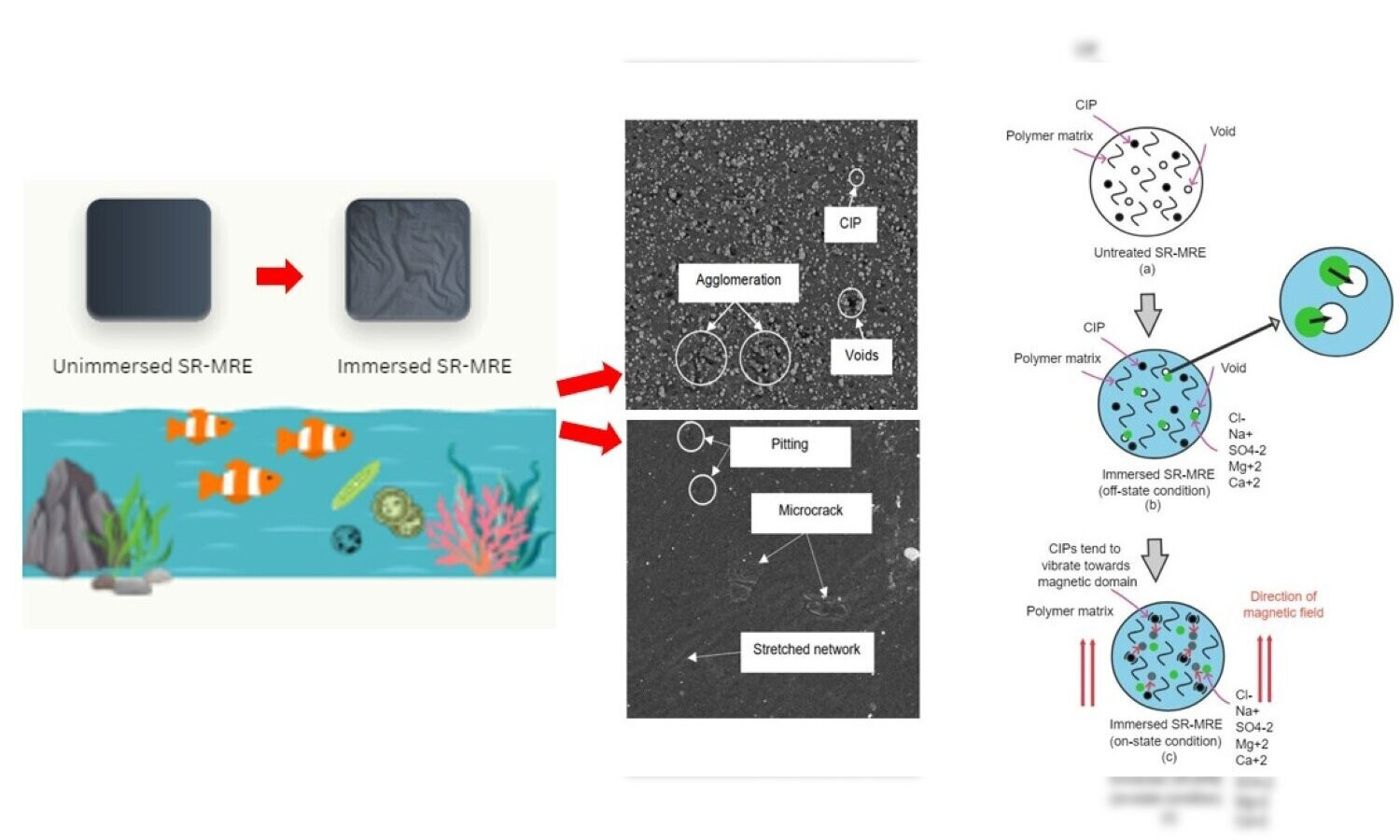
ABSTRACT
Silicone rubber magnetorheological elastomers (SR-MREs) are increasingly recognized for their resilience in marine conditions, offering prolonged service life and durability. This study evaluates the one-month durability of silicone rubber magnetorheological elastomers (SR-MREs) under seawater conditions. Results revealed a 6% reduction in hardness and an 8% decrease in Young’s modulus compared to unimmersed samples. Morphological and attenuated total reflectance-Fourier transform infrared spectroscopy (ATR-FTIR) analyses supported these findings, revealing surface defects and chemical bonding changes. The immersed SR-MRE displayed a notable 250% increase in elongation at break, highlighting enhanced elasticity. Rheological properties revealed complex mechanical behavior, with an initial increase in storage modulus from 0.25 to 0.38 MPa in the presence of a magnetic field, followed by a gradual decrease to 0.15 MPa at 0 A and 0.52 Mpa at 5 A with strain. Additionally, this study proposes an illustrative mechanism to elucidate the relationship between seawater elements and SR-MRE behavior, enhancing our understanding of its mechanical properties and degradation in marine environments, thus highlighting SR-MRE’s potential as a durable material compared to traditional rubber composites.
RELATED ARTICLES
Nabil Hayeemasae, Sitisaiyidah Saiwari, Siriwat Soontaranon, Mohamad Irfan Fathurrohman, Abdulhakim Masa
Vol. 19., No.3., Pages 339-349, 2025
DOI: 10.3144/expresspolymlett.2025.24
Vol. 19., No.3., Pages 339-349, 2025
DOI: 10.3144/expresspolymlett.2025.24
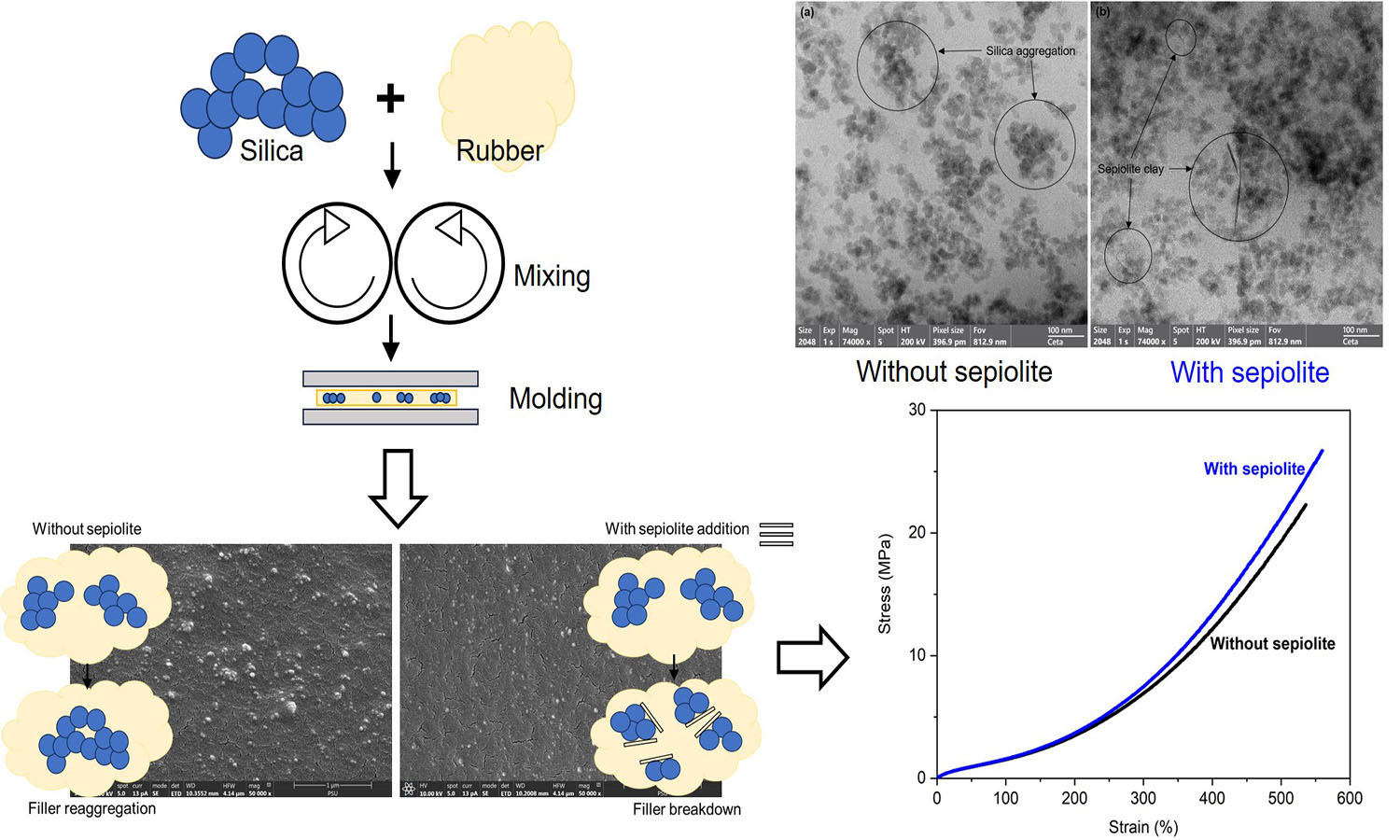
Natural rubber (NR) composites filled with silica and crosslinked with phenolic resin were prepared in this study. The influence of a small sepiolite addition (1–5 part(s) per hundred parts of rubber, phr) on the properties of NR composites was studied. It was found that sepiolite reduced silica aggregate size, allowing improved dispersion in the NR matrix. Sepiolite facilitates silica dispersion by locating at the silica surfaces and acting as a barrier that prevents agglomeration of silica filler. The swelling resistance, crosslink density, tensile strength, and strain-induced crystallization were all strengthened by incorporating sepiolite because of the improved silica dispersion. The greatest tensile strength was achieved at a 2 phr sepiolite addition level. The improvement was about 18% over the reference composite due to the greatest filler-rubber interactions and the finest filler dispersion. The results clearly indicate that sepiolite clay can be applied as a dispersing agent in silica-containing rubber composites.
Mohammad Mehdi Alighanbari, Firoozeh Danafar, Araam Namjoo, Asma Saeed
Vol. 19., No.1., Pages 15-46, 2025
DOI: 10.3144/expresspolymlett.2025.3
Vol. 19., No.1., Pages 15-46, 2025
DOI: 10.3144/expresspolymlett.2025.3
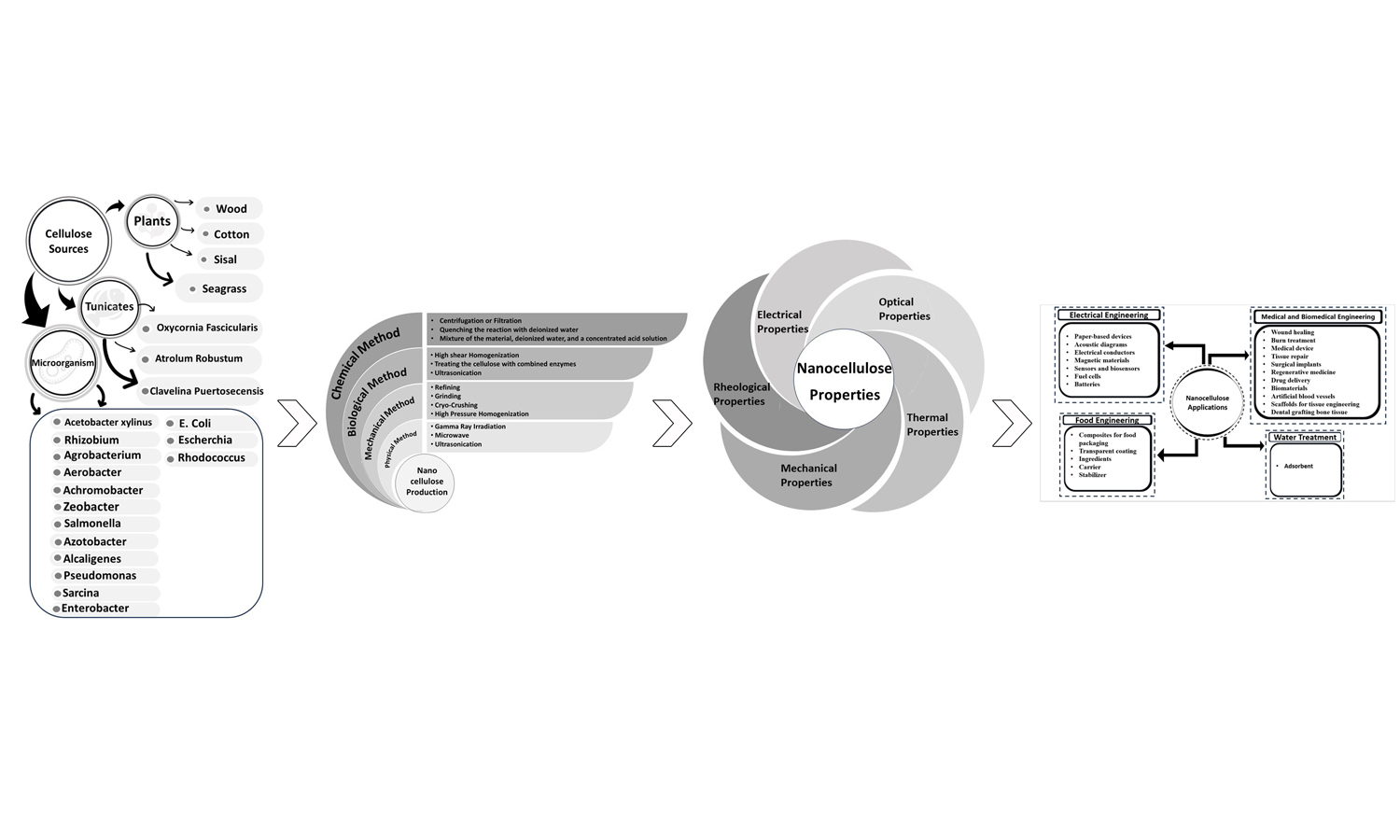
The environmental and ecological concerns drive researchers to synthesize functional materials using components from natural resources. Nanocellulose (NC), derived from plants, marine animals, or microorganisms, is a green material attracting attention due to its abundance, biocompatibility, and biodegradability. NC’s interstice properties enable the synthesis of functional nanocomposites in forms like aerogels, foams, paper, sheets, or hollow filaments. This review briefly describes NC classification and production while comprehensively presenting its mechanical, rheological, optical, and electrical properties, offering foundational knowledge for future research. Additionally, it highlights recent developments in NC-based products across fields such as papermaking, water treatment, civil engineering, electronics, cosmetics, food, and medicine. For the first time, this paper explores recent advances in NC molecular simulation, providing insights into structure, arrangement, and interactions through molecular dynamic simulation. Finally, future prospects for NC-based applications are discussed to encourage studies addressing current challenges.
Shengao Yang, Yan Wang, Fang Wang, Kaiyi Zhang, Xinxin Lv, Hao Teng, Rui Zheng, Faliang Luo, Qian Xing
Vol. 19., No.1., Pages 94-106, 2025
DOI: 10.3144/expresspolymlett.2025.7
Vol. 19., No.1., Pages 94-106, 2025
DOI: 10.3144/expresspolymlett.2025.7
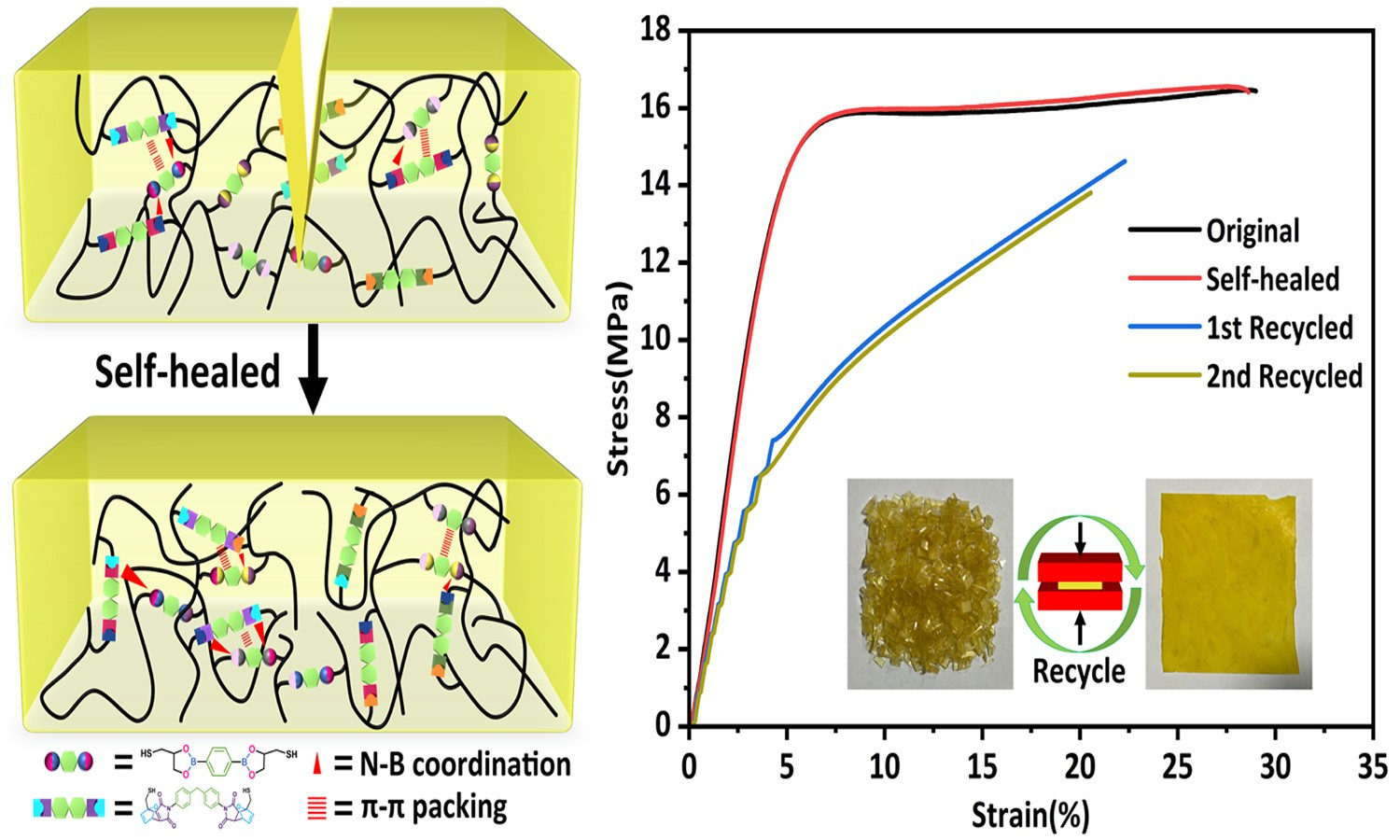
Dynamic cross-linked networks (DCNs) endow thermoset rubber with self-healability and recyclability to extend its lifetime and alleviate environmental pollution. However, the contradiction between high self-healing and mechanical properties in DCNs rubber is always difficult to be resolved. Herein, we used boronic ester (BO) and Diels-Alder dynamic covalent bonds (DA) to synthesize polybutadiene-based dual networks rubber (PB-BO-DA) via thiol-ene reaction. This approach achieved a tensile strength of 16.46 MPa and 99% self-healing efficiency, facilitated by extensive intermolecular interactions (π-π packing and N-B coordination) and fully dynamic cross-linking. In addition, multiple dynamic cross-linked networks (MDCNs) polybutadiene-based rubber also show excellent shape memory ability and recyclability. This strategy might open a helpful pathway to fabricate intelligent multifunctional polymers with high strength and high self-healing efficiency.
Marek Pöschl, Radek Stoček, Petr Zádrapa, Martin Stěnička, Gert Heinrich
Vol. 18., No.12., Pages 1178-1190, 2024
DOI: 10.3144/expresspolymlett.2024.90
Vol. 18., No.12., Pages 1178-1190, 2024
DOI: 10.3144/expresspolymlett.2024.90
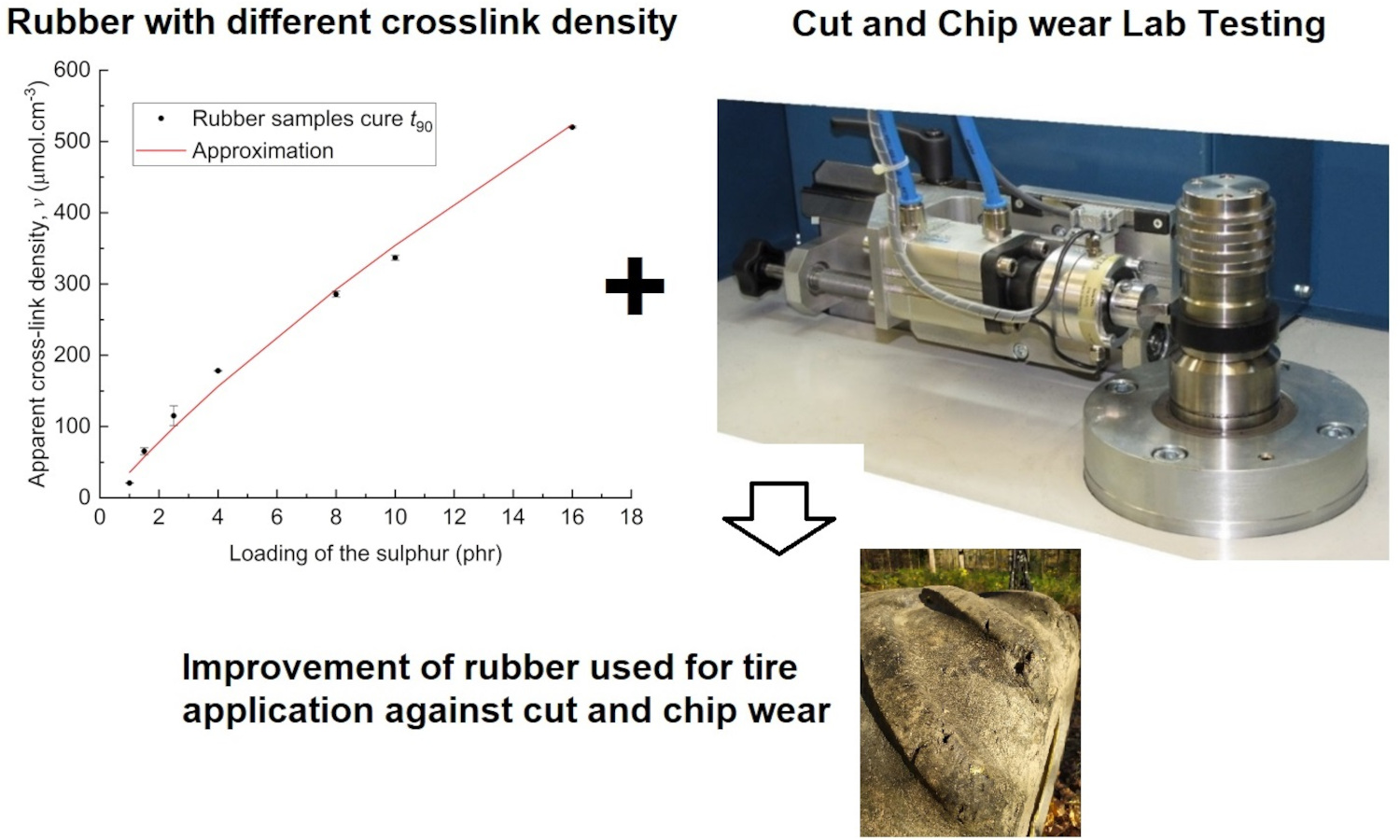
This paper extends previous studies by the authors that aimed to describe the effect of apparent cross-link density (CLD) of the rubber polymer networks on the fracture mechanism caused by cut and chip (CC) wear of natural rubber (NR), demonstrating the positive effect of conventional vulcanization (CV). This work is focused on the determination of the effect of CLD while keeping constant the accelerator-to-sulfur ratio A/S = 0.2, typical for CV systems. For this ratio, different sulfur quantities were chosen, and the concentration of the accelerator N-tert-butyl-benzothiazole sulphonamide (TBBS) was calculated to achieve CLDs in a range from 35 to 524 μmol・cm–3. Standard analyses such as tensile tests, hardness, rebound resilience and DIN abrasion were performed. From these analyses, the optimum physical properties of the NR-based rubber were estimated to be in the CLD range of approximately 60 to 160 μmol・cm–3. A CC wear analysis was performed with an Instrumented cut and chip analyzer (ICCA) and it was found that the highest CC wear resistance of the NR is in the CLD range of 35 to 100 μmol・cm–3. Furthermore, the effect of straininduced crystallization (SIC) of NR on CC wear and its dependence on the CLD region was discussed. For the first time, we determine a CLD range for a CV system in which the material achieves both optimal mechanical properties and CC wear resistance.
Agata Rodak, Józef Haponiuk, Shifeng Wang, Krzysztof Formela
Vol. 18., No.12., Pages 1191-1208, 2024
DOI: 10.3144/expresspolymlett.2024.91
Vol. 18., No.12., Pages 1191-1208, 2024
DOI: 10.3144/expresspolymlett.2024.91
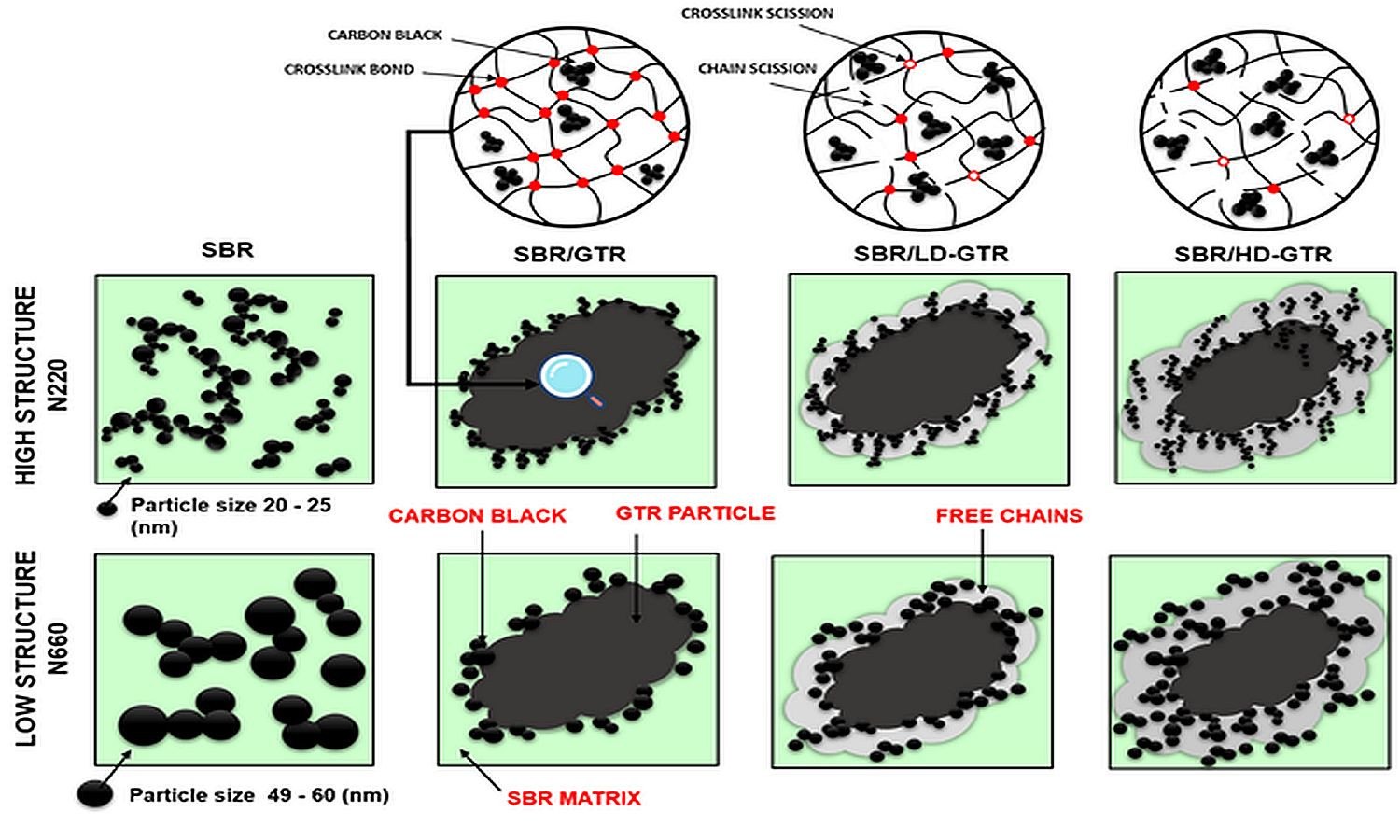
Carbon black migration between ground tire rubber (GTR) and rubber matrix is essential in developing high-performance rubber/GTR composites. In this work, carbon black N220 (surface area: 107.1 m2/g, particle size: 20–25 nm) and N660 (surface area: 33.1 m2/g, particle size: 49–60 nm) were used as the reinforcement fillers for styrene-butadiene rubber (SBR) blended with reclaimed GTR. The combined effects of GTR devulcanization level and carbon black grade on the properties of SBR/GTR composites were investigated considering curing characteristics, thermal stability, physico-mechanical properties, dynamic mechanical properties, swelling behavior, and morphology. The results showed that, regardless of GTR devulcanization level and carbon black grade, application of GTR resulted in deterioration of mechanical properties compared to a reference sample without GTR. It was observed the reinforcement effect of carbon black in SBR/GTR composites was more visible with higher devulcanization level of GTR and lower particle sizes of carbon black fillers. SBR/GTR composites reinforced with carbon black N220 were characterized by tensile strength in the range of 15.3–16.3 MPa and abrasion resistance in the range of 120–123 mm3, which justify their potential application in the manufacturing of technical rubber goods or footwear.



